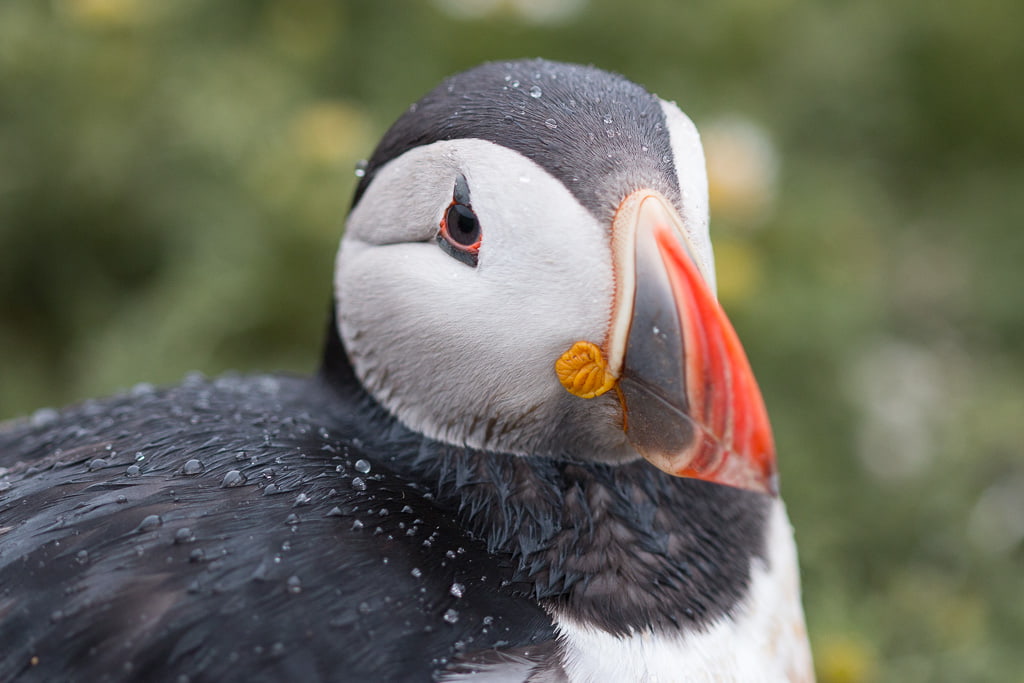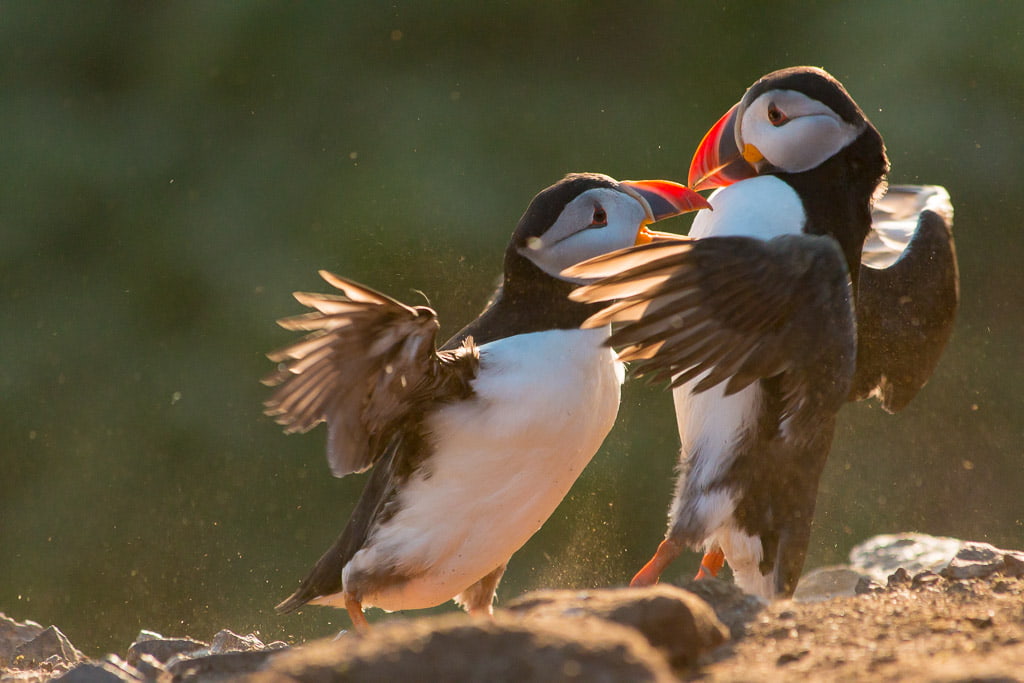Tips for photographing puffins
Photographing puffins is a fun experience. Adapted to life on the open sea, the puffins only come onshore in the UK from May to late July to lay their single egg for the year. As well as the UK coast the Atlantic puffin is found on the Canadian and northern European coastlines including Iceland. Each puffin has its own character and spending time in a colony will allow these personalities to emerge.

This article contains links to products and services that I think you will find useful. I may earn a commission on any purchases you make at no cost to you. As an Amazon Associate, I earn from qualifying purchases. Read more HERE
Where to find puffins in the U.K.
In the UK puffins are found in a number of places. My favourite place is Skomer Island, where a short boat ride in the right conditions can take you to this isolated island. This island is just off the coast of West Wales and is beautiful even without the presence of puffins.
Only 250 visitors are allowed to land on the island each day and tickets have to be bought in advance. Staying on the island is an option and this gives you magical light. It also gives you time alone with the puffins and resident wildlife after the day visitors have left.
Other options are the Farne Islands in Northumberland or Bempton Cliffs in Yorkshire with fewer limits on visitor numbers and easy access. Islands such as the Isle of May, Orkney, Shetland or St Kilda also host puffins, but getting to these islands is an adventure in its own right.
Want to know more about puffins in the UK?
Mini-guide to Puffins
This ebook includes information about the puffin colonies, where to find them and how to visit responsibly. With 20 pages of information, maps and beautiful photographs, it will help you see the puffins on your next summer adventure in the UK.
When is the best time to photograph puffins?

Puffins are seasonal visitors to the UK coastline. They start to arrive in late spring, usually in May.
As the season progresses they will show different behaviours. Early on they are nest-building and courting.
By June they are sitting on eggs and feeding pufflings so the adult puffins will be busy arriving with bills stuffed full of sand eels. During the day they will come and go so it is worth spending time within the colony watching and waiting for individuals to return to their burrows.
In July the pufflings emerge from their burrows and by August the colony is silent as all the adults and young have headed offshore for the winter months.
Best time of day to photograph puffins
Most of the puffin colonies in the UK have puffins coming and going all day. They tend to head off to fish early in the morning but by late afternoon the colony is getting busy again.
Spending a whole day with the puffins will allow you to photograph them as the light changes. If you have limited time to spend with the puffins then aim to arrive mid-afternoon and photograph through until sunset. This will give you gorgeous warm light with more puffins than earlier in the day.
Camera settings to photograph puffins
To photograph puffins you will need to first decide what you are going to photograph. If you want to capture puffins in flight you will need to increase the shutter speed up to at least 1/2000 of a second to eliminate the movement in their wings.
If you are photographing puffin behaviour then a longer shutter speed is acceptable although keeping the shutter speed short will reduce movement in your photograph. Either way, you need to think about settings before getting started.
At all times the ISO needs to be kept low although on cloudy days this can be hard. I usually set mine to around ISO 320 and only adjust it if needed. I would prefer to adjust the aperture size (f-number) before the ISO.
If you want the background to be blurry then a larger aperture is needed. Setting the aperture to between f/2.8 and f/5.6 should ensure an out-of-focus background, this can be enhanced by making sure your puffin and the background are a long distance from each other.
As well as exposure settings you will need to set the focusing mode. If you are using a Nikon camera or Sony Mirrorless camera you need to set autofocus mode AF-C. If you are using a Canon camera then autofocus needs to be set to AI Servo.
Starting points for puffin photography exposures
Sometimes it is hard to know where to start with settings, especially if the light is changing rapidly. This little cheat table should help you get started.
| Weather Conditions | ISO | Aperture | Shutter Speed |
|---|---|---|---|
| Sunny | 100-400 | f/2.8 – f/16 | 1/2000 – 1/8000 |
| Some clouds | 400-800 | f/2.8 – f/8 | 1/2000 – 1/8000 |
| Cloudy and grey | 400-1600 | f/2.8 – f/8 | 1/2000 |
How to photograph puffins – composition Ideas
With limited time with the puffins, there are a number of shots that need to be in mind when visiting their islands. I found that having a list in my mind helped to stop focusing on one thing and going home with a disappointing selection of images.
The weather on the islands can be temperamental but rain can be used to our advantage to give atmosphere to an image. Longer exposure times can show the rain in the background and raindrops on feathers can add to a portrait.

Getting a soft background is achieved by altering the aperture and the distance of the puffin from the background. A soft bokeh is beautiful with puffins and gives intensity to its colours.
The puffins spend a lot of time out at sea fishing and come in to land with beaks full of sand eels. They then make a mad dash for their burrows. It is worth sitting within the colony for a while and figuring out where the puffin will land and where its burrow is located. They will usually land in one spot and make a dash for their burrow!
Flying rugby balls – photographing puffins in flight

One of the other essential shots is a flying puffin, even better if they have a mouthful of sand eels. The puffins really are like flying rugby balls and finding them mid-flight, following them on their approach and capturing them can prove to be a difficult task.
If you want in-flight shots find an area where the puffins are coming in on a regular basis. Pre-focus on a spot and then pick up the bird as it passes through your chosen spot. This means you can use the tracking to hopefully get photographs as it comes into its burrow.

A fast shutter speed is essential to prevent movement blur and this can be helped by opening the aperture fully (f/2.8) if possible. Having the puffin landing into the wind is perfect as it slows them down and gives you time to attempt a shot.
This really is an exercise in reject production, lots and lots of shots for maybe one acceptable attempt.
Capturing puffin behaviour
Living in such close proximity to each other the puffins really do have neighbour issues. It is great to watch them bickering with each other, being mugged by the seagulls for their catch and tending to their burrows with gifts for their mates.

Looking down into burrows (from a distance) can also give an insight into how they spend their time on land. We were fortunate to see a puffin with a puffling at the end of its short life. Not something we planned to see but it showed how the puffins care for their young.

Quirky puffin shots
Puffins are fun to be around and once the classic shots have been achieved time can be taken to watch them and photograph what they get up to.

They spend a lot of time grooming which gives different behaviour patterns. It is also fun to focus on small parts of the puffin – their eyes, bills or feet are good places to start.
Showing the overall environment is also worth considering. A lot of the time the puffin is seen in profile, but the bigger picture of how they live side by side is missed. Using a longer shutter speed and panning as the puffin flies can give an impression of speed, although getting this right can be difficult.

Photographing puffins in the golden evening light
Staying close to a puffin colony gives the opportunity to play with settings and explore the magical light that the evening brings. Without other visitors around it is possible to take time, to move around the colony to get the perfect light.

Back lighting allows the feathers to glow and enhances the puffin in the golden light. High-key images can be achieved with a dark background and having time to sit and experiment can lead to interesting results.

One Day or more for puffin photography
Most people only get a day with the puffins and so planning and focus are needed. To make it a better experience I would highly recommend staying on the island and having more time, better light and quieter times with these fantastic little birds.
By having more than one day with puffins you can capture them in different weather and light conditions as well as at different times of the day.
During the day their behaviour changes and it is lovely to watch them pass the time.

Kit Bag Essentials
I am a bit of a light photographer when it comes to trips. Some take huge bags and tons of lenses, but I like what I have and use very little. So here are the basics!
While I list DSLR lenses you can use these tips for any camera whether it is a point-and-shoot, bridge camera or phone camera.
- Waterproof bag and clothing – the weather can be unpredictable
- Range of lenses – my 150-600mm got used a lot but I found the lighter 70-200mm more manageable. Look at the aperture size as well. In low light, f1.4 or f2.8 will help a lot. I also used my 17-55mm lens for night shots and environment shots.
- Polarising filter – really useful for landscape photography
- Tripod – essential for night photography if you are staying on the island. We were lucky and managed to capture the northern lights.
- Kneeler – lots of time spent sitting and kneeling within the colony. A set of knee pads or a waterproof cushion are essential for comfort
- Batteries – there is limited power on Skomer Island so if you are visiting for any period of time make sure you have plenty of power. This is the same for any of the puffin locations.
- Memory – lots and lots of memory. Better to have too much than to have to spend time deleting images to make space on memory cards.
- Patience – this isn’t a quick snap-and-capture, time is needed to get the shots you want.
Want to learn more about photography? Read more on my photography page.
Want to know more about puffins in the UK?
Mini-guide to Puffins
This ebook includes information about the puffin colonies, where to find them and how to visit responsibly. With 20 pages of information, maps and beautiful photographs, it will help you see the puffins on your next summer adventure in the UK.